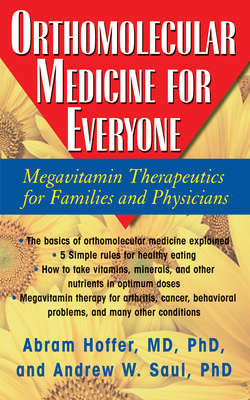Читать книгу Orthomolecular Medicine for Everyone - Abram Hoffer M.D. Ph.D. - Страница 54
Vascular Disorders
ОглавлениеNiacin has been used on a fairly wide scale for a number of vascular disorders. Studies began in 1938 and were based on the vasodilatation caused by niacin. Niacin, even by intravenous infusion, is very benign. The so-called niacin flush causes a transient, slight increase in blood pressure, which rarely reaches 10 percent above the baseline and returns to normal within five minutes. This is followed by a transient decrease in pressure, seldom more than 10 percent, with the effect on systolic pressure more pronounced. For all practical purposes, there is very little effect. Circulation time is decreased up to 25 percent, and cardiac output is increased due to an increase in systolic stroke volume. Pulmonary resistance is decreased, as is peripheral resistance, while oxygen consumption is increased.
There are a number of indications for niacin, including vasomotor headaches, regional angiospasm, amaurosis caused by spasms in the retina, cerebrovascular spasms, and acrospastic syndromes.18 The type of headache that responded is characterized by spells of nonpulsating pain with paleness and retinal angiospasm. Some researchers have found niacin to be the treatment of choice for embolism. Thus, 100 mg of niacin given intravenously after an embolus in large proximal vessels alleviates the pain within a few minutes. The paleness eases, as do hypothermia and cyanosis. For a few days following, niacin is given intravenously every 2–4 hours, then every 6–8 hours.19 Niacin also helps in treating end arteries (cerebral, spinal, renal, mesenteric, and retinal), but the results are not as dramatic. One of my elderly patients became blind in one eye following an embolus in the retinal artery. On 3,000 mg per day of niacin, this suddenly cleared several weeks later and he regained his vision.
Niacin is also the treatment of choice for abnormal arterial clotting, easing disorders of restricted blood supply caused by blocked arteries. It is helpful for claudication, and it has removed the necessity for amputation following diabetic gangrene.20 It is the best treatment for end artery thrombosis, but again its curative effects are not as dramatic as for thrombosis of the extremities. I have used it for strokes and found it very valuable in restoring brain function. It appears as if surrounding tissues are able to regain function and take over some of the function of destroyed brain tissue.
Vitamin B3 was also found very useful in treating coronary disease. Angina of effort was improved; disorders of the ventricular conduction system were improved, as was coronary insufficiency. However, niacin must not be used in acute infarction with shock, but it can be started once circulation is established when it will limit the area of irreversible ischemic damage.
In one case, a female patient of mine (A. H.) suffered from severe nephritis that her nephrologist declared untreatable. He began to prepare her for dialysis, as there was no hope that anything else would help. Her nephrologist was one of the best known and admired specialists in the field. I advised her to consider using 3,000 mg per day of niacin in consultation with her physician. He dismissed this idea out of hand! However, when she weighed the alternative, she concluded that she would try niacin. Within a month, she was well and has remained well. Animal studies confirm these earlier clinical observations, finding that niacin significantly lowered blood sugar levels in diabetic rats and retarded development of diabetic nephropathy.21
For all vascular conditions, researchers have generally started with niacin given intravenously, using 100 mg injections. Perhaps similar results could be achieved using larger oral doses.
